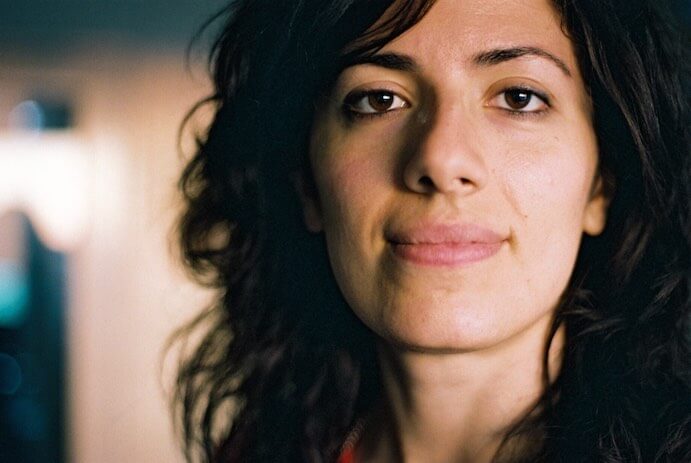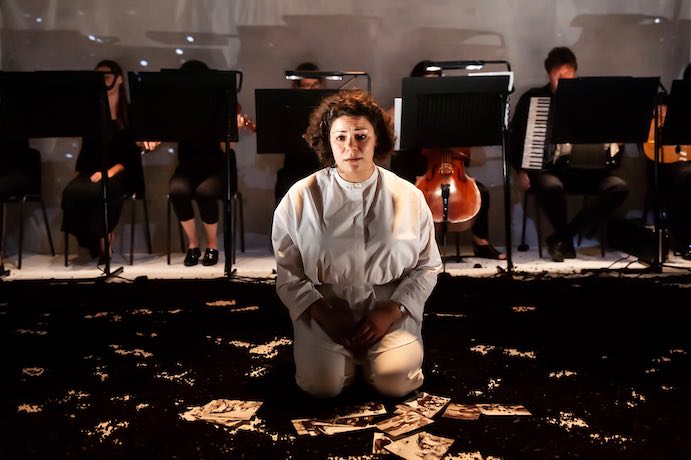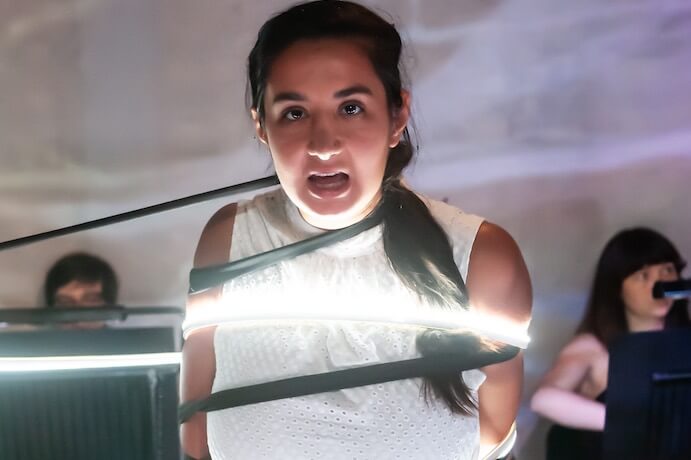It’s summer opera festival season in the UK–so, are you a Glyndebourne or a Grimeborn person? Country house in Sussex, or a converted factory in east London? Mostly standard repertoire, or an adventurous programme with plenty of contemporary discoveries? Membership advised if you want to attend, or accessible pricing? Picnic on the lawn in the supper interval, or walk round the corner to the finest Turkish kebab joints in town? Glyndebourne’s founder, John Christie, “encouraged the wearing of formal dress to show respect to the singers and musicians,” while Grimeborn say “Whether it’s your first or your latest opera experience, you’ll be right at home.”
Grimeborn it is. Their summer season takes place in the carbon neutral Arcola Theatre: it wouldn’t be entirely accurate to say the factory has been renovated–walls are unfinished and facilities are basic–but Grimeborn brought its unique approach to opera to both performance spaces. On 9 August, I saw Silk Moth, a triple bill mounted by Ruthless Jabiru in the more intimate space.
An ensemble of Australian musicians directed by Kelly Lovelady, Ruthless Jabiru describe themselves as “a London chamber orchestra dedicated to new music and humanitarian stories.” They collaborate with activists and campaigners, making them an excellent fit for the central work on the programme, Bushra El-Turk’s Silk Moth, a story of female genital mutilation and ‘honour’-based violence. The final work on their programme was Bel Canto (2010) by Canadian composer Cassandra Miller, “a portrait of Maria Callas, based on her live recording of Puccini’s Vissi d’arte–with all the full generosity of her vibrato, swoops and portamenti.” Miller’s work often takes recording transcriptions as a starting point and Lovelady’s intention was to use this piece as an opportunity for “controlled reflection.”

The set played without a break and the staging connected all three works, starting with an ash-like substance falling onto a heap on the white floor. The programme began with The Heart’s Ear (1997) for flute, clarinet and string trio by fellow Australian Liza Lim, with the instrumentalists in a row at the back of the room and Lovelady conducting from a corner. This 12-minute-long “meditation on a fragment of a Sufi melody” is a study in ambiguity and wavering pitch, combining sinuous arabesques with more incisive, dense textures. The ensemble were strong advocates for the work, though the dry acoustic did them no favours. Towards the end, we became aware that the black heap was moving; a female performer emerged and cast off the net in which she was encased, to a backdrop of projected images of opening flowerbuds.
The actor left the stage and Silk Moth started. Composed by Bushra El-Turk, a Londoner of Lebanese heritage who is fully in tune with Ruthless Jabiru’s mission to see art as a means for social change, to a libretto by Eleanor Knight, Silk Moth “explores the story of a mother implicated in the gender abuse and honour killing of her own daughter. […] the role of Mother calls for a rare agility across Arabic and operatic vocal styles in equal measure.”

The British-Egyptian mezzo Camille Maalawy, experienced in Arabic and Sephardic singing styles as well as Western classical music, was a perfect fit for Mother. Mona Khalili, Karim Jabri, Shira Agmon, Sophie Atalar and Aivale Cole acted as foils to Mother and represented the suffocating family and community through Heather Fairbairn’s effective “choreographic opera” direction. Khalili, the daughter, had a speaking role, but significantly only Mother had a singing voice.
Simple gestures–reacting to photos or looking at a tablet–spoke volumes, and at the climax, Khalili was tied up using a rope light and black scarf. Maalawy emerging wearing a rubber glove was enough to suggest the act of mutilation, though the projected text was far more graphic: “This flesh, pink cut, cast down on the floor/Is your promise to them that I will never want more.” The daughter read, deadpan, the lifecycle of the silkworm: it weaves its own cocoon, and it must die, unable to emerge as a fully-grown moth, in order for the cocoon to be harvested intact. Silk is a commodity; so, it is suggested, is a woman’s life.
Maalawy was not only a strong singer, but also an excellent actress who brought a warm humanity to Mother and projected complex emotion even when reacting to a phone screen. The character might have had a voice, but Maalawy’s layered portrayal suggested she had little agency. El-Turk’s music created its own world with a small number of instruments. The hollow timbre of the ney was underpinned by astringent accordion, and intricate interweaving violin and cello built up to some powerful climaxes.

Seamlessly, the music shifted to Bel Canto with the four female performers as singers, their descending lamenting lines echoing the drooping glissandi of the instrumental ensemble. The women had a voice, but no words; they could sing, but only by imitating and repeating. The repetition was utterly captivating in context, a lament for all that went before, and the singers falling to their knees and running ashy material through their fingers emphasised the sorrow of being stuck in a groove, both literally and metaphorically. Towards the end, a loud solo violin shocked with reiterated descending glissandi, like mewing, joined by the four women. Is there an end to all this? Other than by the music simply stopping, it appears there isn’t.
This was a daring and powerful theatrical evening which lasted less than an hour, but whose emotion will resonate for far longer. So many Western musicians have used generic Eastern figurations as decoration, or to evoke something mesmerising and incantatory. It’s beautiful, but what this programme showed is that the same musical gestures have a flip side and can be a telling theatrical metaphor: mesmerising and incantatory can also equal directionless and trapped.
























